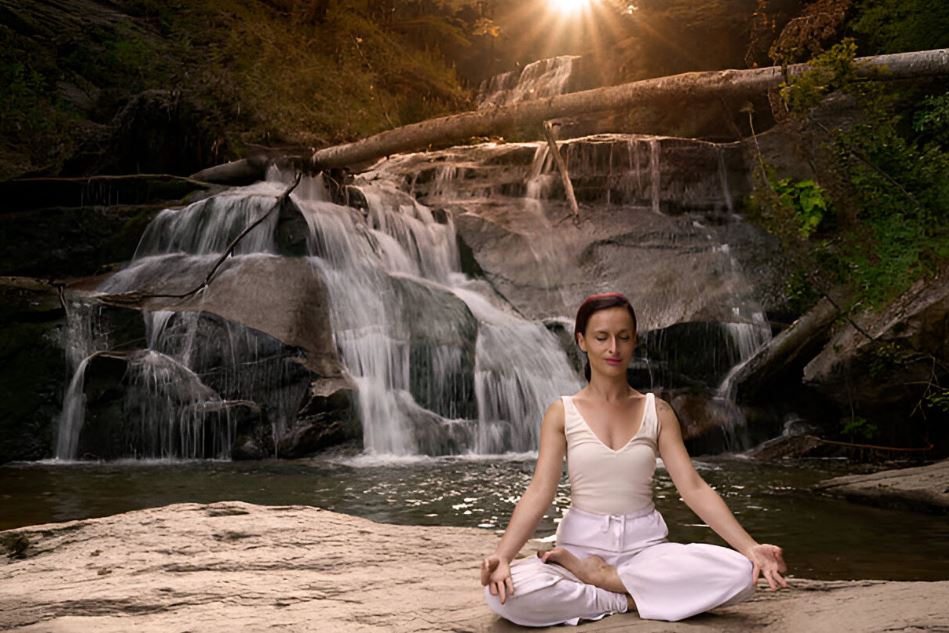Rishikesh, nestled in the foothills of the Himalayas, is often called the world capital of yoga. Every year, thousands of students from around the globe come here to learn yoga in its most authentic form. But not every yoga teacher training program (YTT) in Rishikesh is created equal.
If you are planning to join a yoga training in Rishikesh, it’s essential to know what sets a high-quality program apart from the rest. In this article, we’ll explore 7 clear signs of a truly excellent yoga teacher training course.
1. Accreditation from Yoga Alliance
One of the first things to check is whether the yoga school is registered with Yoga Alliance USA. This global accreditation body ensures that the training program follows international standards.
Why It Matters:
- A Yoga Alliance certification means that the curriculum includes the essential elements of yoga, such as asana, pranayama, anatomy, philosophy, and teaching methodology.
- It allows you to become a Registered Yoga Teacher (RYT) after completing your course.
- It enhances your career opportunities, both in India and abroad.
Tip: Look for RYS 200, RYS 300, or RYS 500 designations on the school’s website to confirm they are officially registered.
2. Experienced and Authentic Teachers
A high-quality yoga course in Rishikesh is defined not just by the syllabus but also by the teachers who deliver it. Your learning experience depends heavily on their knowledge, teaching style, and spiritual depth.
What to Look For:
- Teachers who have trained in traditional ashrams or under Indian yoga masters.
- Instructors with over 5–10 years of teaching experience.
- A team with diverse specializations — such as Hatha, Vinyasa, Anatomy, Ayurveda, Meditation, and Yoga Philosophy.
Bonus Sign: A good school will usually include guest lectures or workshops by renowned yogis, Ayurvedic doctors, or philosophers.
3. Balanced and Structured Curriculum
The course syllabus should be well-organized, ensuring that all fundamental aspects of yoga are covered. Many low-quality schools skip essential areas or focus only on physical postures.
A Good Curriculum Includes:
- Asana practice (Hatha, Ashtanga, Vinyasa, etc.)
- Pranayama (breathing techniques)
- Meditation and mindfulness training
- Yoga philosophy (Bhagavad Gita, Patanjali’s Yoga Sutras)
- Teaching methodology and practicum
- Human anatomy and yoga alignment
- Kriyas (cleansing techniques)
Red Flag: If a program focuses only on physical yoga or rushes through content, it’s not a complete yoga training.
4. Small Class Sizes for Personal Attention
Learning yoga is not like attending a lecture; it’s a deeply personal journey. One-on-one corrections and individual attention are vital.
Signs of Student-Centric Learning:
- Class sizes are kept small (ideally under 20 students).
- Teachers give individual feedback during asana practice.
- The environment feels nurturing and non-judgmental.
- Open sessions or Q&A circles are held regularly.
This ensures that every student, regardless of experience level, is supported and guided properly.
5. Clean and Peaceful Location
Rishikesh is filled with yoga centers, but only a few are located in peaceful, natural settings that support spiritual growth. Your surroundings will directly affect your energy and focus during the training.
What to Look For:
- Proximity to the Ganges River or nestled in the Himalayan foothills
- Quiet, pollution-free surroundings far from traffic and crowds
- On-site accommodation and healthy vegetarian meals
- Clean yoga halls and hygienic bathrooms
- Nature walks, Ganga Aarti, or excursions that support holistic living
Note: An authentic yoga training experience in Rishikesh should feel like a retreat — away from the noise, close to nature.
6. Positive Reviews and Word-of-Mouth Reputation
Before committing to a school, research what previous students have said. Online reviews, testimonials, and YouTube vlogs can offer real insight into the school’s quality.
Where to Check:
- Google Reviews
- Trustpilot and Yoga Alliance directories
- Social media pages and Facebook groups
- YouTube student experiences
- Travel forums like Reddit, Quora, or TripAdvisor
Look for patterns in the reviews. A few negative comments are normal, but if multiple people mention the same issues (e.g., poor food, rude staff, lack of structure), it’s a warning sign.
Pro Tip: Directly message a past student on Instagram or Facebook for an honest opinion.
7. Focus on Inner Transformation, Not Just Certification
Yoga is more than postures and certificates. A truly great training will encourage deep self-inquiry, lifestyle change, and spiritual awakening.
Signs of Transformative Training:
- Time for daily silence or journaling
- Classes on yogic lifestyle and ethics (Yamas and Niyamas)
- Encouragement to adopt satvik food, early rising, and mindfulness
- Teachers who lead by example — humble, kind, and rooted in yogic values
Such a course will not only train you to teach yoga but help you live yoga in your daily life.
Bonus Tip: Transparency and Pre-Arrival Support
A reliable yoga school will always be transparent in its communication before you even arrive in Rishikesh.
Things to Expect:
- Prompt and polite replies to emails or WhatsApp inquiries
- Clearly detailed course itinerary
- Help with visa, airport transfer, and local travel info
- No hidden charges
If a school is disorganized or vague in the beginning, it’s a sign of deeper problems during the training itself.
Final Thoughts
There are hundreds of yoga schools in Rishikesh — some life-changing, others disappointing. Choosing the right one is a big decision, not just for your yoga journey but also for your physical, emotional, and spiritual growth.
If a program checks these 7 signs:
- Recognized by Yoga Alliance
- Led by experienced teachers
- Has a complete, balanced curriculum
- Offers small class sizes
- Located in a serene, clean setting
- Enjoys positive word-of-mouth
- Focuses on your inner journey
…then it’s likely a high-quality yoga teacher training in Rishikesh that’s worth your time and investment.
Always remember: the best yoga school is not the fanciest one, but the one that helps you connect with your inner self and prepares you to share the light of yoga with others.
If you’re looking to truly disconnect from the noise of daily life, a peaceful yoga retreat in Rishikesh offers the perfect setting. Surrounded by the calming flow of the Ganges and the stillness of the Himalayas, these retreats are designed to restore inner balance through gentle yoga, meditation, and silence. Unlike rushed programs, a peaceful retreat gives you time to slow down, reflect, and reconnect with your true self. It’s an ideal choice for anyone craving mental clarity and emotional healing in a nurturing environment.
Ready to Begin?
Take your time, do your research, and trust your intuition. Whether you’re pursuing yoga for personal growth or to become a teacher, Rishikesh offers the perfect setting — as long as you choose yoga training wisely.
📌 Frequently Asked Questions (FAQs)
1. Why is Rishikesh considered the best place for yoga teacher training?
Rishikesh is often called the “Yoga Capital of the World” due to its spiritual atmosphere, abundance of experienced teachers, and its deep-rooted connection to ancient yogic traditions. Training here offers a truly immersive experience in the birthplace of yoga.
2. How can I tell if a yoga teacher training program is high-quality?
Look for signs such as experienced instructors, Yoga Alliance certification, a well-structured curriculum, small class sizes, positive student reviews, a strong focus on both practice and philosophy, and a supportive learning environment.
3. Is Yoga Alliance certification necessary?
While not legally mandatory, Yoga Alliance certification ensures that the training meets international standards. It’s recognized globally and can help you teach yoga professionally around the world.
4. What’s the typical duration of a YTT program in Rishikesh?
The most common courses are 100-hour, 200-hour, 300-hour, and 500-hour programs. The 200-hour course is often the starting point for aspiring yoga teachers and generally lasts about 24 to 28 days.
5. What styles of yoga are usually taught in high-quality programs?
Authentic programs in Rishikesh typically offer Hatha and Ashtanga yoga, with some schools including Vinyasa Flow, Yin, or Kundalini. The best courses provide a balance of physical practice, breathwork (pranayama), meditation, and philosophy.
6. Do I need prior experience in yoga to join a teacher training course?
Many 200-hour YTT programs are designed for beginners to intermediate practitioners. However, having a regular yoga practice and basic understanding of yoga concepts can be helpful.
7. What should I expect from the daily schedule?
A typical day includes early morning meditation, multiple asana classes, philosophy lectures, anatomy sessions, teaching practice, and time for self-study or reflection. The routine is often intense but deeply rewarding.
8. Are accommodations and meals usually included?
Yes, most yoga schools in Rishikesh offer accommodation and sattvic (pure vegetarian) meals as part of the course package. Always confirm the facilities and food options before enrolling.
9. How do I verify if student reviews are authentic?
Look for reviews on third-party platforms like Google, Trustpilot, or Yoga Alliance. You can also join Facebook groups or forums and ask past students for genuine feedback.
10. Can I teach yoga professionally after completing a YTT in Rishikesh?
Yes! After completing a certified YTT course, you’ll be eligible to register as a yoga teacher (RYT) and start teaching in studios, online, or even open your own classes, depending on your comfort and experience level.



